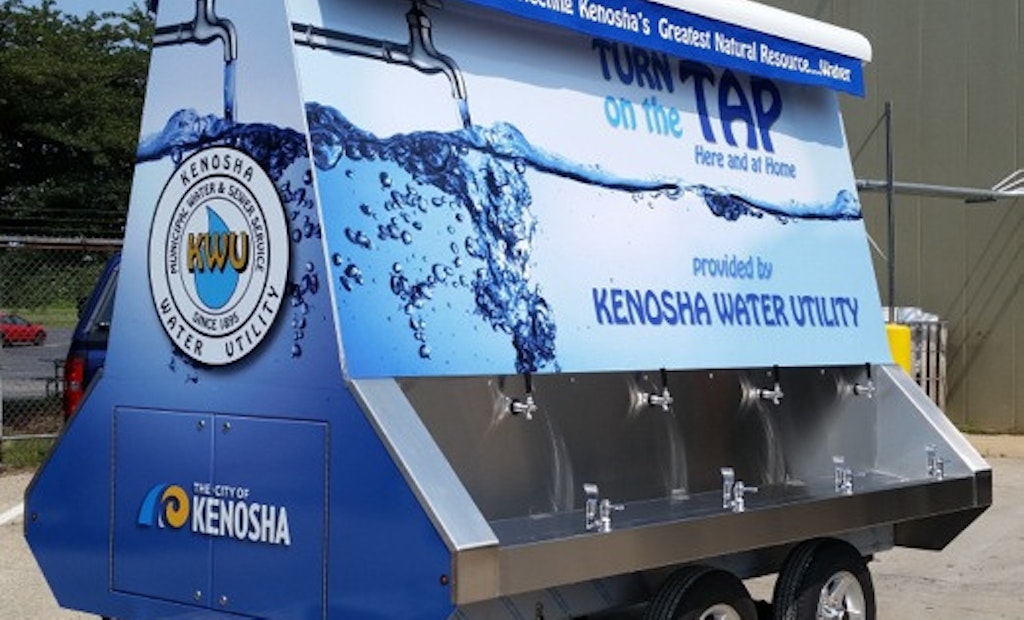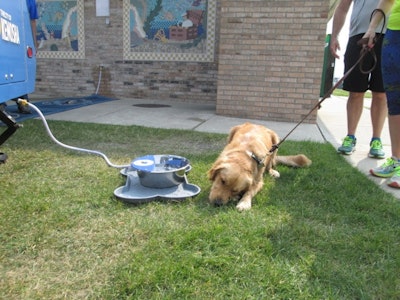
Interested in Education/Training?
Get Education/Training articles, news and videos right in your inbox! Sign up now.
Education/Training + Get AlertsCool tap water is making a splash across southeastern Wisconsin this summer. Since making its debut during the Fourth of July weekend, Kenosha’s Traveling Tap wagon has received two thumbs up from thirsty residents and their canine companions.
“It’s better than bottled water,” says Ed St. Peter, general manager of the Kenosha Water Utility and a driving force behind the outreach initiative.
St. Peter is passionate about the water the utility produces and rates it hands-down better tasting and better for the environment than anything on the grocery shelf.
“Almost any municipal water is better than bottled water,” he says. “The regulations on municipal water are considerably higher than on bottled water. Our water is treated and within a week — max — you’ve used it. Bottled water can sit on the shelf for three years and in some cases up to five years in a plastic bottle. That doesn’t sound good to me.”
St. Peter says for $1, Kenosha Water can keep 1,599 plastic bottles out of the landfill by refilling a 20-ounce container 1,600 times.
“That’s what we want to promote,” he says. “We’re looking at doing some major education on tap water, period. Bottled water is ridiculous. It’s a convenience that good marketing has made to seem like a necessity. High school kids, junior high kids, they all have to have a bottle of water — for what? You go into a restaurant in Kenosha and you say you want a bottle of water — are you kidding me — when there’s tap water you can get for free and of higher quality?”
St. Peter hopes the wandering water wagon will further educate the public on the benefits of drinking Kenosha’s tap water.
“Municipal water systems really don’t market,” he says. “We have a monopoly. We just sell the water. Great Lakes water — you can’t beat it.”
The Kenosha Water Utility pumps water through 42- and 48-inch intake pipes that extend about a mile into Lake Michigan to its production plant on Simmons Island. Raw water passes through sand filters and microfiltration equipment before it's blended, treated and delivered to about 100,000 customers. The utility delivers 5 billion gallons of water each year through 345 miles of water main, or about 100 gallons of water per customer per day.
“Water is pretty important to us and to me,” St. Peter says. “I’ve been doing this for 45 years.”
Inspired by the City of Madison’s (Wisconsin) Water Wagon, Kenosha’s portable drinking station has eight bubblers, eight taps and a watering bowl for pets. The tap has already made stops at Saturday morning markets and attended triathlons and bike races, with plans for future activities.
“There’ll be a number of municipally sponsored events that we know we will be at,” St. Peter says. “The question moving forward is: Do we do it for nonprofit organizations, a church picnic or a big fundraiser? If the Heart Association is having a walk, how will we incorporate that? And I want to. But will there be fees for a non-city function? And if a for-profit wants the tap, will we do it and what will we charge?”
St. Peter even received a request from neighboring Racine to use the tap at Greek Fest, which created a bit of a dilemma.
“Are we going to let the unit run somebody else’s water through it, not Kenosha’s? I don’t know,” he says. “No one has water like Kenosha.”
The stainless steel water wagon, which cost about $20,000 to build, connects to a fire hydrant or building that has water service.
“If it’s on a hydrant, we flush the hydrant and test it for bacteria,” St. Peter says.
During Fourth of July festivities at Harbor Park, the tap provided refreshment for 2,500 guests and 350 pets.
“The dog thing was really a hit,” he says.
The dual-axle Traveling Tap is 11 feet long, 9 feet tall and 10 feet wide. Built by 25 of the utility’s 90 employees, work started in February and was completed July 3.
The tap includes 60 feet of 1/2-inch PEX plumbing and 40 feet of 3/4-inch copper tubing that cools the water as it passes through an ice-packed heat exchanger-type device.
An overhead awning displays the utility’s motto: "Providing and protecting Kenosha’s greatest natural resource." Blue graphics encourage visitors to “turn on the tap here and at home.”
St. Peter says there are no immediate plans for a second Traveling Tap.
“I wouldn’t say it’s out of the question,” he says. “I want to see how this one works – how often it’s used and how effective it is – but I think it’s going to be very effective. We’ve had nothing but compliments.”







